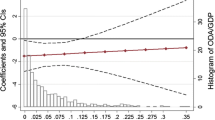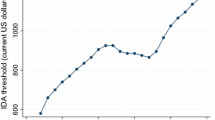Abstract
Recent aid effectiveness literature centers on two competing models from the family of conditional models: The Good Policy Model, where the key feature is policy times aid, and the Medicine Model, where it is aid squared. Both models were reached on a sample of 1/3 of the available data. The models are simplified to be replicatable on more of the data. Within-sample the Good Policy Model proves fragile, while the Medicine Model is more robust. Both models fail in out-of-sample replications. A semi-parametric technique is used to test for an unknown functional form of the aid-growth term. It rejects that aid is statistically significant.
Similar content being viewed by others
References
Aerts, M., Claeskens, G., & Hart, J. D. (1999). Testing the Fit of a parametric Function. Journal of the American Statistical Association, 94(447), 869–879.
Alesina, A., & Dollar, D. (2000). Who gives foreign aid to whom and why? Journal of Economic Growth, 5, 33–36.
Apostol, T. M. (1972). Mathematical Analysis. 2nd ed. Addison Wesley, Reading, MA.
Barro, R. J. (1974). Are Government Bonds Net Wealth? Journal of Political Economy, 82, 1095–1117.
Barro, R. J. (1997). Determinants of Economic Growth. A Cross-Country Empirical Study. MIT Press: Cambridge, MA.
Brunetti, A. (1998). Political Variables in Growth Regressions. Cpt 6, 117–135 in : Broner, S., Paldam, M., (eds), The Political Dimension of Growth. Macmillan for the IEA: Houndmills, UK.
Burnside, C., & Dollar, D. (2000). Aid, Policies and Growth. American Economic Review, 90, 847–68. World Bank working paper in several versions from 1996.
Burnside, C., & Dollar, D. (2004). Aid, policies and growth: Reply. American Economic Review, 94, 781.
Cassen, R. (1986, 1994). Does Aid Work? Clarendon: Oxford.
Chang, C. C., Fernandez-Arias, E., & Serven, L. (1998). Measuring Aid Flows: A New approach. World Bank URL: http://www.worldbank.org/research/growth/ddaid.htm.
Clemens, M., Radelet, S., & Bhavnani, R. (2004). Counting chickens when they hatch: The short term effect of aid on growth. WP Nr 44. Center for Global Development.
Collier, P., & Dollar, D. (2004). Development effectiveness: What have we learnt? Economic Journal, 114, 244–271.
Dalgaard, C. J., & Hansen, H. (2001). On aid, growth and good policies. The Journal of Development Studies, 37, 17–41.
Doucouliagos, C., & Paldam, M. (2005a). Aid effectiveness on accumulation. A Meta Study. Mimeo Economics Department, University of Aarhus, Denmark. (The three studies are referred to as one. They are available from http://www.martin.paldam.dkor the WP series of the Department of Economics, Aarhus Univ.)
Doucouliagos, C., & Paldam, M. (2005b). Aid effectiveness on growth. A meta study. Mimeo Economics Department, University of Aarhus, Denmark.
Doucouliagos, C., & Paldam, M. (2005c). Conditional aid effectiveness. A Meta Study. Mimeo Economics Department, University of Aarhus, Denmark.
Easterly, W., Levine, R., & Roodman, D. (2004). Aid, policies, and growth: Comment. American Economic Review, 94, 774–780 (Comment to Burnside and Dollar, 2001) Earlier: New data, New doubts. NBER WP 9846.
Gørgens, T., Paldam, M., & Würtz, A. (2003). How Does Public Regulation Affect Growth? Mimeo Economics Department, University of Aarhus, Denmark.
Hadjimichael, T. M., Ghura, D., Muhleisen, M., Nord, R., & Ucer, E. M., (1995). Sub-Saharan Africa: Growth, Savings, and Investment, 1986–93. IMF: Occasional Paper,No. 118.
Hansen, H., & Tarp, F. (2000). Aid effectiveness disputed. Journal of International Development, 12, 375–339. Also pp 103–128 in Tarp and Hjertholm (2000).
Hart, J. D. (1997). Nonparametric Smoothing and Lack-of-Fit Tests. New York: Springer Verlag.
Hudson, J. (2004). Introduction: Aid and Development. Economic Journal, 114, 185–90, with contributions by Collier and Dollar, Dalgaard, Hansen and Tarp, and Mosley, Hudson and Verschoor.
Jensen, P. S., & Würtz, A. (2005). The ill-posed problem in growth empirics. WP, CAM, Department of Economics, University of Copenhagen.
Keefer, P., & Knack, S. (1995). Institutions and Economic Performance: Cross-country tests using alternative institutional measures. Economics and Politics, 7, 207–227.
Lensink, R., & White, H. (2001). Are there negative returns to aid? Journal of Development Studies, 37, 42–65.
Levine, R., & Renelt, D. (1992). A sensitivity analysis of cross-country growth regressions. American Economic Review, 82, 942–963.
Mavrotas, G. (2002). Foreign aid and fiscal response: Does aid disaggregation matter? Weltwirtschaftliches Archiv, 138, 534–559.
Paldam, M. (2004). Are vote and popularity functions economically correct? pp. 49–59 in: Rowley, C. K. and Schneider, F., (eds), The Encyclopedia of public choice, Vol I. Kluwer Academic Publishers, Dordrecht.
Ricciuti, R. (2003). Assessing ricardian equivalence. Journal of Economic Surveys, 17, 55–78.
Sala-i-Martin, X. (1997). I just Ran two Million regressions. American Economic Review, 87, 178–183.
Tarp, F., & Hjertholm, P., eds. (2000). Foreign aid and development. Lessons Learnt and Directions for the Future. Routledge Studies in Development Economics, London.
WDI (2003). World Bank Indicators 2003, CD-ROM, also on the internet.
World Bank (1998). Assessing Aid: What Works, What Doesn't and Why. Oxford UP, Oxford, UK.
Author information
Authors and Affiliations
Corresponding author
Rights and permissions
About this article
Cite this article
Jensen, P.S., Paldam, M. Can the two new aid-growth models be replicated?. Public Choice 127, 147–175 (2006). https://doi.org/10.1007/s11127-006-0865-4
Accepted:
Issue Date:
DOI: https://doi.org/10.1007/s11127-006-0865-4




